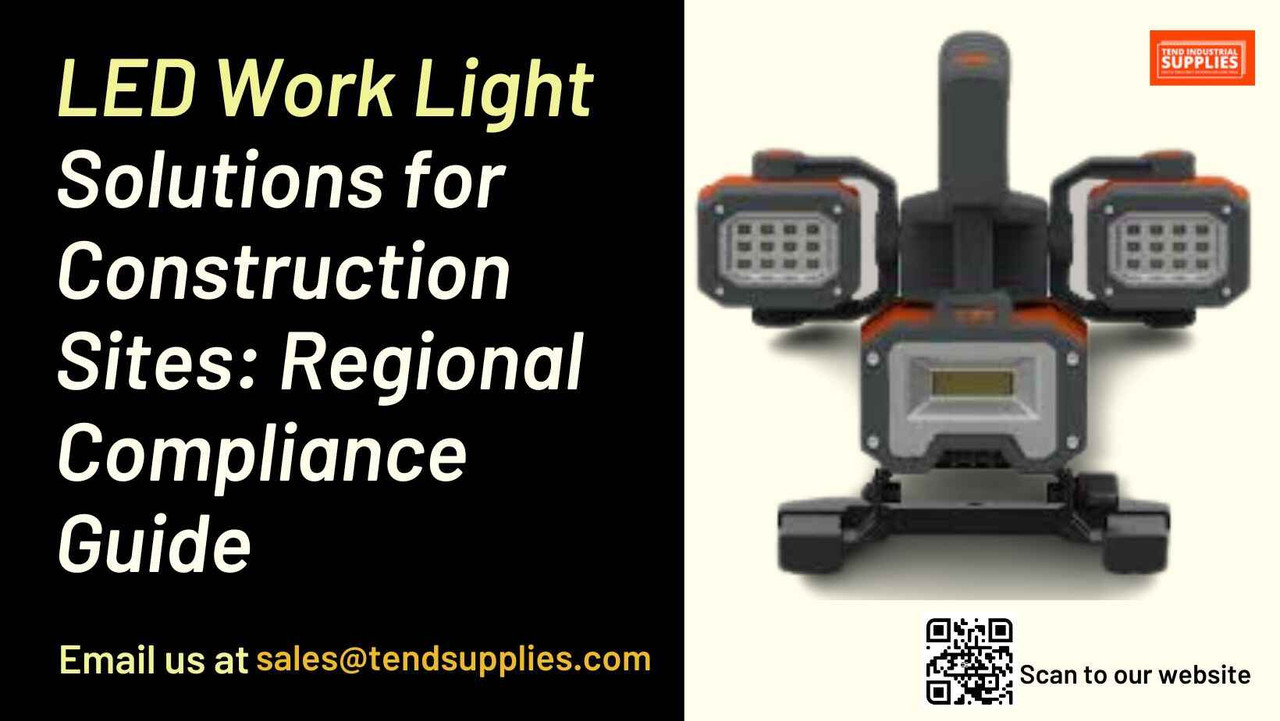LED Work Light Solutions for Construction Sites: Regional Compliance Guide
Key Takeaways
- LED work lights must meet specific regional safety standards
- Proper illumination levels vary by task and location
- Energy efficiency requirements differ by state
- Environmental conditions affect lighting solution selection
- OSHA compliance varies by region and application
Introduction
Ensuring proper lighting is essential on construction sites, where visibility directly impacts worker safety and project efficiency. LED work lights offer a durable, energy-efficient solution tailored for the demands of these environments. However, different regions have specific compliance requirements regarding illumination standards, light intensity, and energy consumption.
This guide covers the essential features of LED work lights for construction sites, while highlighting regional regulations and best practices for compliance. With this information, you can equip your site with high-quality, compliant lighting to improve productivity and keep workers safe across all project phases.
Understanding Illumination Requirements
Minimum Light Levels for Construction Tasks
| Task Type | Required Foot-Candles | Recommended LED Lumens |
| General Construction | 5-10 | 1,000-2,000 |
| Detailed Assembly | 20-50 | 4,000-10,000 |
| Fine Detail Work | 50-100 | 10,000-20,000 |
| Emergency Lighting | 3-5 | 600-1,000 |
| Access Ways | 5 | 1,000 |
Regional Compliance Requirements
Northeast Region Regulations
The northeastern United States, including states like New York, Pennsylvania, and Massachusetts, maintains strict requirements for construction site lighting. These regulations are particularly focused on urban construction sites where light pollution and neighbor impact must be carefully managed.
Key Requirements:
- Light trespass limitations: Maximum 0.1 foot-candles at property lines
- Emergency backup requirements: Minimum 90 minutes of operation
- Color temperature restrictions: 3000K-4000K in residential areas
- Weatherproofing: IP65 rating minimum for wet conditions
Southern Region Considerations
In states like Florida, Texas, and Georgia, extreme heat and humidity create unique challenges for construction site lighting. Regional requirements focus on equipment durability and heat management.
Essential Features:
- Heat dissipation systems rated for 120°F operation
- UV-resistant housing materials
- Corrosion-resistant components for coastal areas
- Hurricane-rated mounting systems in applicable zones
Midwest Construction Lighting
Midwestern states face extreme temperature variations and severe weather conditions, requiring robust lighting solutions that can handle everything from blizzards to tornadoes.
Specific Requirements:
- Impact resistance: IK08 rating minimum
- Temperature operation range: -40°F to 100°F
- Wind resistance ratings for elevated installations
- Snow and ice accumulation considerations
Western Region Standards
Western states, particularly California, lead the nation in energy efficiency requirements and environmental considerations for construction lighting.
Compliance Needs:
- Title 24 compliance in California
- Dark Sky compliance in designated areas
- Seismic mounting requirements
- Renewable energy integration options
LED Technology Specifications
Modern LED Features
Advanced LED work lights have evolved significantly, offering features essential for construction applications:
- Intelligent Controls
- Motion sensors for energy conservation
- Daylight harvesting capabilities
- Remote operation options
- Programmable timing systems
- Environmental Protection
- IP66-IP69K ratings available
- Impact resistance up to IK10
- Chemical resistance coatings
- Anti-corrosion treatments
- Energy Management
- Smart power management
- Variable output settings
- Power factor correction
- Surge protection systems
Application-Specific Solutions
Interior Construction Lighting
Interior construction requires careful consideration of light distribution and glare control. Modern LED solutions offer:
- Adjustable beam angles (15° to 120°)
- Anti-glare diffusers
- Color rendering index (CRI) >80
- Flexible mounting options
Exterior Construction Sites
Outdoor construction lighting must balance visibility with environmental impact:
- Directional light control
- Minimal light pollution design
- Wildlife impact consideration
- Weather-resistant construction
Emergency and Safety Lighting
Every construction site requires reliable emergency lighting systems:
- Battery backup systems
- Automatic activation
- Compliance indicators
- Regular testing capabilities
Energy Efficiency Considerations
Power Consumption Analysis
Modern LED work lights offer significant energy savings:
Traditional Halogen vs. LED Comparison:
- 500W halogen = 150W LED equivalent
- Annual energy savings: 70-80%
- Reduced HVAC load in enclosed spaces
- Lower generator requirements
Cost Benefits
Investment analysis shows clear advantages:
- Initial cost recovery: 8-14 months
- Maintenance reduction: 75%
- Bulb replacement: Every 50,000 hours
- Energy cost reduction: Up to 80%
Installation and Maintenance
Proper Installation Procedures
Safe installation ensures optimal performance:
- Site Assessment
- Load calculations
- Mounting point evaluation
- Power source verification
- Access requirements
- Safety Considerations
- Fall protection integration
- Electrical safety compliance
- Emergency access planning
- Regular inspection schedules
Frequently asked questions
1. What IP rating do I need for outdoor construction sites?
For most outdoor applications, minimum IP65 rating is required, with IP67 recommended for severe weather exposure.
2. How often should LED work lights be inspected?
Monthly inspections are recommended, with detailed quarterly assessments of mounting, electrical connections, and performance.
3. Can LED work lights operate in extreme temperatures?
Quality LED work lights should operate from -40°F to 120°F, but performance may vary by manufacturer.
4. What backup power requirements exist for construction site lighting?
Most regions require minimum 90-minute battery backup for emergency lighting paths and exits.
5. How do I calculate the required number of work lights for my site?
A: Use the area square footage and required foot-candles to determine total lumens needed, then divide by the output of each fixture.
Related Articles
- LED Work Lights Buyer's Guide
- Top 5 Energy-Efficient Work Lights
- Maximizing Worksite Efficiency with LED Lighting
- Best Portable Work Lights for Construction
- Waterproof vs. Magnetic LED Worklights
Take Action
Ensure your construction site meets all lighting requirements while maximizing efficiency and safety. Contact Tend Industrial Supplies for expert guidance on selecting the perfect LED work light solutions for your specific needs.
Contact us today:
- Email: sales@tendsupplies.com
- Visit:www.tendsupplies.com
- Browse ourLED work light collection
Don't compromise on-site safety and visibility. Let our experts help you choose the right lighting solutions that meet all regional requirements while maximizing productivity and efficiency.









